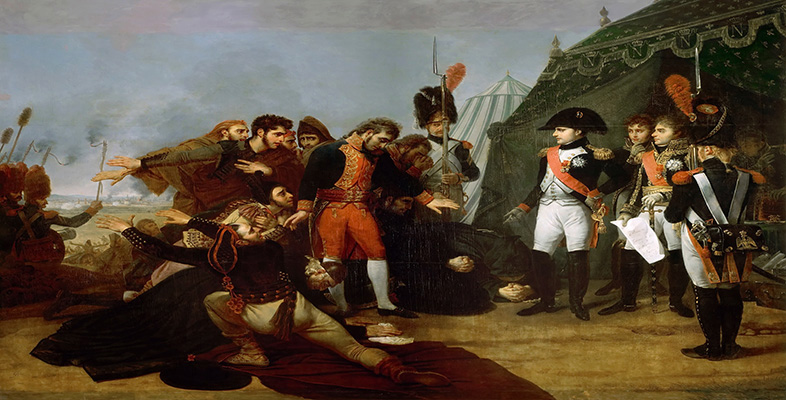3 Gros and the Napoleonic propaganda machine
3.1 The limits of propaganda
Although portraits of Napoleon were manufactured on a large scale and distributed widely, they could only act as propaganda for the regime up to a certain point. Given the institutional circumstances sketched out in the introduction to this course, the most effective way to use art as propaganda was with large-scale history paintings that would attract the attention and excite the interest of a large audience when they were exhibited in the Salon. State patronage for such painting was revived on a lavish scale under Napoleon, a development that was very welcome to artists after the lean years of the Revolution, during which very few works were commissioned by the government. However, Napoleonic patronage was also characterized by a much tighter control over the form and content of history painting than had previously been the case, in order to ensure that the resulting works fulfilled the propaganda objectives of the regime. The works in question were, above all, paintings of military subjects. Just as French men were conscripted en masse into the army, so French painters were enlisted in the service of the empire to celebrate the battles the soldiers fought: in 1811 a critic described David, Gros and other leading artists as ‘the generals of painting’ (quoted in Wrigley, 1993, p.337). French art was thus subjected to the control of a propaganda machine, paralleling the strict censorship and surveillance imposed on every other form of expression.
These shifts in French painting were heralded quite soon after Bonaparte seized power; in a letter of 1800 he wrote to his brother Lucien, the minister of the interior, listing six battles that he wanted to have depicted and asking him to select appropriate painters for the task. One of them was the battle of Marengo, while the others were all drawn from his Egyptian (in fact, Middle Eastern) campaign of 1798–9, despite the fact it had ended in failure. From the first, therefore, not only did the regime turn to military painting for purposes of propaganda, but it is also evident that a certain sleight of hand was involved; that is to say, the Napoleonic strategy was not to pretend that a setback had never occurred, but boldly to present even a disaster as a triumph. This holds especially true of the two paintings that we will be focusing on here: Gros's Jaffa, which deals with the most inglorious episode of the entire Egyptian campaign, and Eylau, which depicts a problematic episode from a later campaign. Two points need to be made in advance. First, both paintings rely on a notion of France's ‘civilizing mission’, in which enlightened ideals are harnessed to a new nationalistic and also colonialist agenda. Second, both also testify to the limitations of Napoleon's strict censorship laws, since it was precisely because news of what had really happened was circulating in France that the regime found it necessary to promote its own version of events. (We will come back to both points.)
